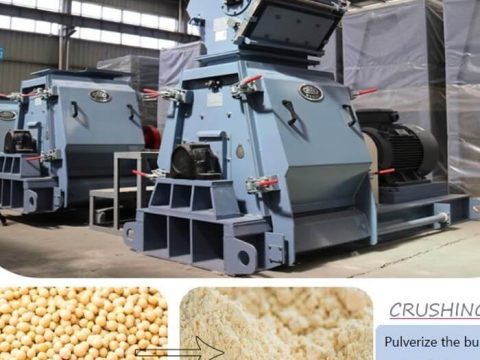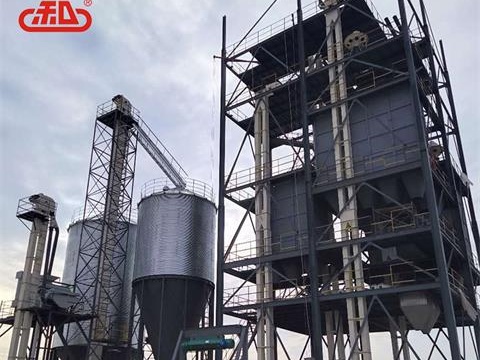Generally speaking, the factors that affect granulation include the source of raw materials, moisture in the raw materials, starch, protein, fat, crude fiber content, bulk density, material structure and particle size, etc.
- Particle size: The powder is crushed finely, which is conducive to hydrothermal treatment. On the contrary, powder with coarse particle size has low water absorption capacity and poor conditioning effect.
- Bulk density: The bulk density of materials has a direct impact on output. When the same granules are made, the output is high and the power consumption is small when granulating materials with heavy volume. On the contrary, the output will be low and the power consumption will be high.
- Influence of chemical composition of materials
1) Starch: Different forms of starch have different effects on granulation. The surface of raw starch particles is rough and has great resistance to granulation. When the raw starch content is high, the granulation yield is low and the die wear is serious. Raw starch particles have poor binding ability with other components, and the final product is loose. The cooked starch, that is, the gelatinized starch, exists in a gel form after being tempered and absorbing water. The gel is conducive to the material passing through the die holes, thereby increasing the granulation output. At the same time, after the gel is dried and cooled, it can bond with other surrounding components, making the granular products have better quality. During the quality process, the starch granules are partially damaged and gelatinized during steam cooking and extrusion by die and pressure rollers, resulting in viscosity, which makes the granules produced have a precise structure and improved quality. In addition to being related to the structure and properties of various starches, it is also related to the fineness of the powder. Therefore, when corn and sorghum are used as the main raw materials, attention should be paid to the crushing particle size before pelleting.
2) Protein: The protein is heated and deformed, which enhances the bonding force.
3) Grease: The inherent grease in the raw materials does not cause the oil to be squeezed out due to the temperature and pressure during the granulation process, so it does not have a great impact on granulation. However, the addition of external grease has a significant impact on the output and quality of granulation. Influence. Adding 1% grease to the material will soften the particles, significantly increase the granulation output, and reduce the wear of the die and rollers. However, the oil content of the raw material before granulation is high, and the resulting granules are loose. The amount of oil added before granulation should be limited to 3%.
4) Molasses: Usually the amount added is less than 10%. It can be used as a binder and is good for enhancing the hardness of particles. Its effect depends on the material's ability to absorb molasses.
5) Fiber: It has no adhesive force, but if there is too much fiber and the resistance is too great, the output will be reduced and the die will wear out quickly. Materials with high crude fiber content are loose and porous inside, so the moisture content in the mold should be controlled. If the moisture content is too high and the temperature is also high, the particles will expand rapidly after being released from the mold and are prone to cracking.
6) Heat-sensitive raw materials: When adding certain vitamins, seasonings and other materials that are easily damaged by heat for granulation, the granulation temperature should be appropriately lowered and excessive amounts should be added to ensure the effective content of these ingredients in the finished product.
- Binder: Some feeds do not contain much starch, protein or other binding ingredients, making it difficult to make granules. Therefore, a binder needs to be added to make the particles achieve the desired firmness.
What are the physical and chemical changes of proteins, carbohydrates, fats and vitamins during the granulation process:
protein:
Physical changes: The protein will show a tendency of decreasing protein water solubility. Different types of raw materials will have different degrees of decrease in water solubility under granulation conditions due to their different protein contents. The general trend is that the higher the protein content, the greater the decrease in water solubility. Secondly, the fuzziness. The greater the fuzziness, the smaller the water solubility of the protein.
Chemical changes: The protein is gradually reduced, and the hydrolysis time of the protein in the digestive tract is reduced. The protein content remains basically unchanged during the entire process, and the decrease in amino acid stability and potency is basically unobvious.
carbohydrate:
Physical changes: Starch absorbs water and begins to dissolve, losing its original crystal structure. Different raw material starches have different swelling temperatures. Under high-temperature extrusion conditions, the starch can reach the required degree of starch gelatinization. This modulation process can achieve the needs of improving granulation and nutrition at the same time. This structural form has protective properties and Function to improve feeding effect.
Chemical changes: In addition to puffing, starch also undergoes hydrolysis, thus providing more suitable conditions for enzymatic digestion of feeding animals. The pelleted feed has good hygienic indicators and contains almost no source of pathogens.
Changes in fat: High temperature inactivates lipase, reduces the hydrolysis of fat during storage, improves stability, and inactivates lipoxygenase, which splits the protective structure of fatty acids, reducing the rate of acidification.
Vitamins: Friction is the main factor that makes vitamins unstable. It destroys the crystal layer of vitamins and oxidizes a large amount of vitamins. Pressure can seriously damage the gel layer of fat-soluble vitamins such as vitamin A.

